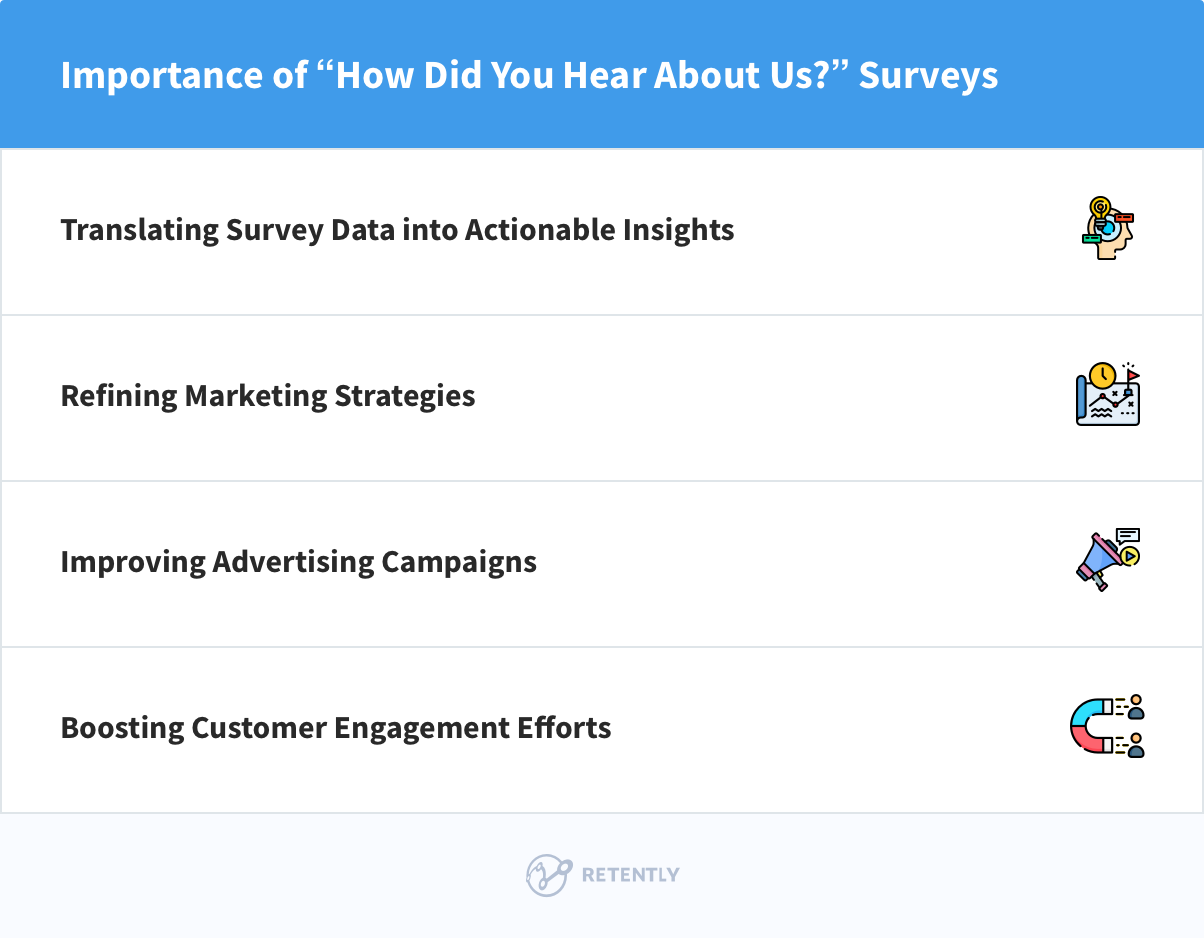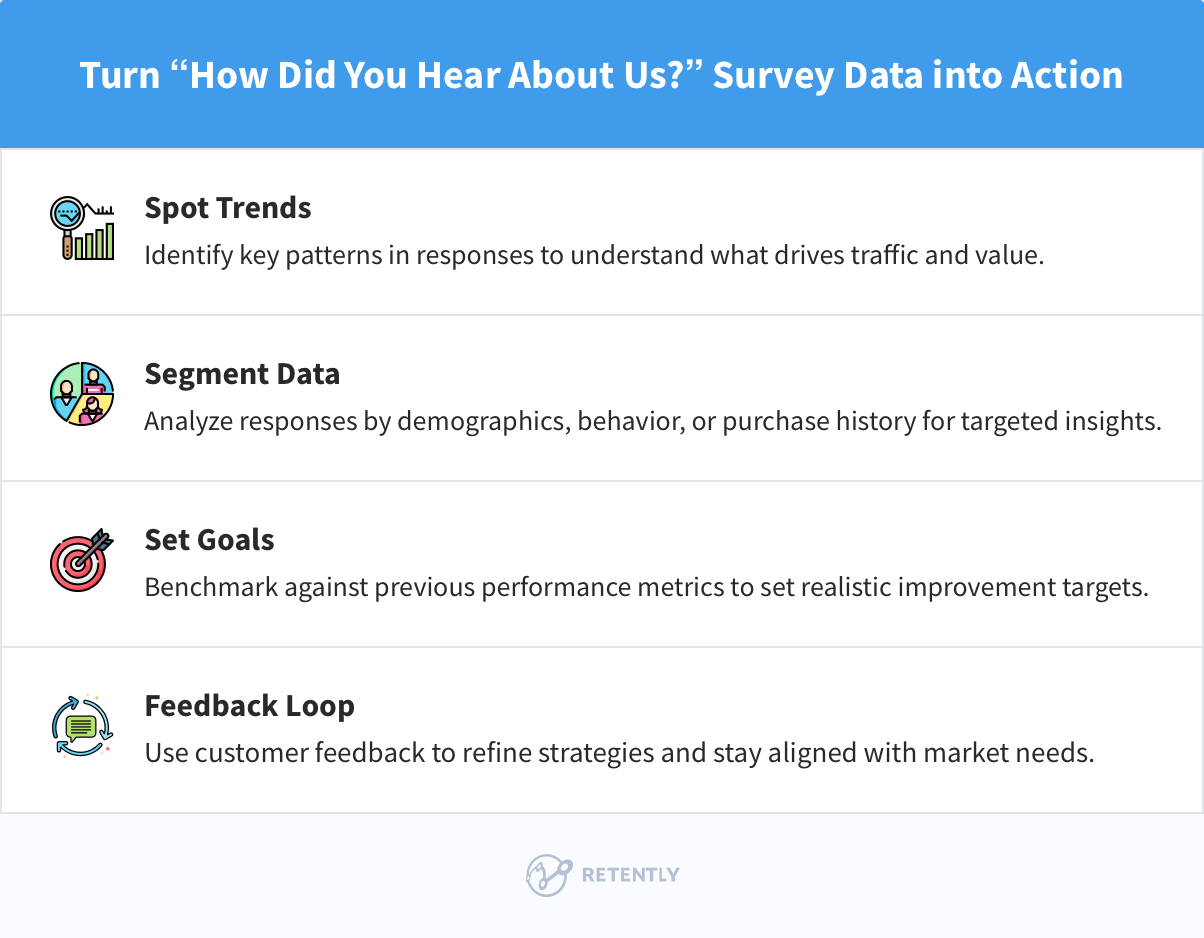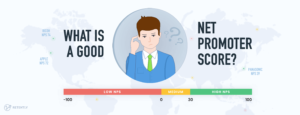Are you wondering which channels are effectively leading customers to your business? “How did you hear about us?” surveys are critical tools for uncovering this information, directly influencing your marketing strategy and budget allocation. By pinpointing where your customers come from, you can streamline your efforts, enhance engagement, and grow your business. In this article, we’ll guide you through crafting, placing, and analyzing impactful surveys that provide actionable data for your business growth.
Key Takeaways
- “How Did You Hear About Us?” surveys provide actionable insights into the effectiveness of marketing strategies and boost engagement by truly valuing the voice of the customer.
- A successful survey design involves strategic placement, timing, and simple multiple-choice questions to increase participation and the accuracy of collected data.
- Analyzing “How Did You Hear About Us?” survey data helps identify effective marketing channels, adapt campaigns for better ROI, and build stronger customer relationships through informed strategy adjustments.
The Importance of “How Did You Hear About Us?” Surveys
“How Did You Hear About Us?” surveys go beyond being a mere item on your marketing checklist. They are instrumental in driving your business growth. These surveys serve a dual purpose: they inform about your marketing campaign’s performance and engage your customers by acknowledging their opinions.
Imagine knowing exactly which marketing platforms effectively contribute to your customer’s journey and which are simply draining your budget. That is precisely the kind of clarity these surveys can provide, allowing you to align your marketing strategy for maximum impact.
Understanding your marketing channels
Having a clear understanding of your marketing channels is like having a roadmap to guide your marketing efforts. “How Did You Hear About Us?” surveys can reveal which platforms or channels successfully engage your customers.
The information you glean from these surveys is especially valuable for cloud-based or SaaS businesses. It can highlight the importance of leveraging algorithms that facilitate information sharing online. Likewise, for companies using traditional marketing methods, these surveys can assess the impact of non-digital efforts like flyers and in-person events.
Enhancing customer engagement
These surveys do more than just help you understand your marketing channels; they also serve as a bridge between you and your customers. Including open-ended questions or a comment box in your survey allows your customers to voice their experience and provide valuable feedback.
By analyzing these comments, businesses can gain a comprehensive understanding of customer satisfaction and preferences. It gives a peek into how people view your ads, communications, and overall support, shaping your content marketing strategies.

Crafting the Ideal “How Did You Hear About Us?” Survey
Once you appreciate the significance of these surveys, the subsequent step is to design one that will yield the insights you’re after. An ideal “How Did You Hear About Us?” survey involves considering several key elements.
First of all establish clear, actionable objectives. Knowing what you aim to achieve with your survey will not only influence the questions you ask but also how you interpret the collected data.
The timing and positioning of your survey can encourage participation, while the natural fit of this survey question, among others within the customer feedback questionnaire, can increase the chances of getting a response. Ideally, the survey should be placed during key moments, such as checkout or in a confirmation email, to capture practical information.
Select the relevant answer options
Choosing the appropriate answer options is an important stage in designing your survey. A multiple-choice format with detailed sample answers allows for faster and more consistent analysis over interpreting qualitative responses. These options should reflect the broad spectrum of your marketing efforts, including social media, search engines, word of mouth, advertising campaigns, and any other channels relevant to your business.
However, the challenge lies in selecting which channels to include. For a thorough approach, think about your marketing strategies and the places where your target audience is most likely to come across them. It’s important to keep these strategies fresh and up to date, adjusting for any changes in your marketing approach or the introduction of new platforms.
For example, if you are a cloud-based or SaaS business, including internet-related answers like “Search Engines”, “Social Media”, or “Customer Review Sites” can help you understand how customers find your website. Don’t forget to include an “Other” option to capture data that might not fit into your predefined categories, and consider the role of a “Google search” in driving traffic to your site.
Include an “Other” answer option
While predefined answers can simplify analysis, as already mentioned, it’s equally important to include an “Other” option. This open-ended response allows customers to provide information about discovery channels you may not have considered or are unaware of. The insights gathered from these responses can be invaluable, revealing unexploited avenues for customer acquisition or highlighting emerging trends in consumer behavior.
Additionally, this option respects the respondent’s experience by acknowledging that their discovery path might not fit neatly into predefined categories. It encourages engagement by allowing them to share their unique journey, which can foster a deeper connection with your brand.
Keep it simple and concise
To boost response rates and gather meaningful insights, your survey questions must be engaging and easy to understand. The key is simplicity; questions should be direct and concise, avoiding any jargon or complex wording that might confuse respondents. The primary question, “How did you hear about us?” should be positioned prominently. This direct approach helps minimize drop-off rates and encourages more customers to share their experience.
A straightforward multiple-choice format can prevent respondents from feeling overwhelmed and allows them to quickly select an answer, improving the completion rate of the survey. Predefined answer options simplify the process for customers and facilitate more straightforward analysis for businesses.
Timing and placement
The effectiveness of your survey is significantly influenced by its timing and positioning. For maximum engagement, use survey channels with high customer interaction, such as:
- Emails
- Text messages
- In-app surveys
- Website pop-ups
Experiment with multiple channels to catch a wider array of customer insights and lessen the bias tied to any single channel. Keep an eye on how each platform performs, tweaking your approach to favor those that bring in richer responses. Some platforms may yield more responses or higher-quality data than others.
Tailor channel selection to your target audience’s preferences and behaviors. Younger demographics might be more reachable via social media, while professional audiences might engage more through email or LinkedIn. Regardless of the channel, always prioritize user privacy and be clear about your data usage.
In terms of timing, align your survey with recent customer interactions to ensure accurate responses. Strategically embedding the survey on web pages or blogs with high customer engagement can also optimize the survey’s visibility.
Innovative Alternatives to Traditional “How Did You Hear About Us?” Questions
Despite the merits of the traditional “How Did You Hear About Us?” survey question, it can be beneficial to consider more innovative options at times. Creative alternatives to this question can give you a broader understanding of customer behavior and preferences.
These alternatives can provide insights into your customer’s motivations and the context in which they discovered your business, providing valuable information for refining your targeting and messaging strategies.
“What prompted you to visit our website/store?”
The question “What prompted you to visit our website/store?” can reveal the specific triggers leading to a customer’s interaction with your business. For example, if you’re an online service provider, this question can help you understand if customers discovered your website through search engines, social media, or organic content. Likewise, this question allows event organizers to gain valuable insights into their attendance drivers.
“Which of our marketing campaigns caught your attention?”
Asking, “Which of our marketing campaigns caught your attention?” can identify the marketing initiatives that are memorable and effective in attracting genuinely interested customers.
Providing specific answer options like:
- Promotional Videos
- Television
- Newspaper
- Billboard
- Podcast
allows businesses to measure the effectiveness of specific advertising campaigns. This question can provide valuable insights into how effective the campaign’s creative messages are and how much they align with the audience’s values and interests.
“What factors influenced your decision to choose us?”
The question “What factors influenced your decision to choose us?” provides another layer of understanding about your customers. Knowing the context in which customers found your business, such as looking for a solution or just browsing the top choices within the niche, can inform content creation and platform investment.
Recognizing the impact of word-of-mouth referrals, customer testimonials, and customer reviews is important in understanding their influence on potential customer decisions.
Analyzing and Leveraging Survey Data
After collecting the survey data, the subsequent stage is its analysis. Continuous monitoring and analysis of “How Did You Hear About Us?” survey results can help identify what channels are successfully contributing to customer acquisition.
These insights can provide actionable data for adapting and optimizing marketing campaigns to achieve better outcomes.

Identify trends and patterns
Are there certain channels consistently driving more traffic? Do some marketing efforts yield better quality leads or customers with higher lifetime value?
Start with a quantitative review of the responses to identify the most common discovery channels. This will give you a broad overview of which marketing efforts are effectively driving awareness and acquisition.
For open-ended responses or “Other” options, this can involve categorizing responses into themes or trends that may not have been previously considered. Specialized survey software or text analysis tools can assist in interpreting qualitative feedback and identifying recurring themes, sentiments, and keywords within survey comments with ease. If you conduct surveys regularly, analyzing the data over time can reveal trends in how discovery channels evolve.
Look at the data through various lenses, such as demographic segments, customer behavior, or purchase history. This segmentation can reveal nuanced insights, like which channels are most effective for reaching specific audience segments.
Understanding why customers come to your business can guide what content you create and where you decide to invest in terms of platforms. Trends in customer feedback can tell how to address common complaints and implement suggestions for improvement.
Link Responses to Campaigns
This could mean associating answers with specific advertising campaigns, social media initiatives, search engine marketing efforts, or even offline activities like in-person events. By doing so, you will figure out which efforts are generating awareness and, more importantly, customer action.
For digital campaigns, this might involve correlating responses with metrics from Google Analytics, social media analytics, or advertising platform reports. For offline efforts, it might require a bit more creativity, such as using unique campaign codes or asking for more detailed information about the event or advertisement that led the customer to you.
Adapt and optimize marketing campaigns
The success of your marketing campaigns can be directly impacted by the survey insights. By refining your marketing strategies and identifying effective triggers for customer visits, you can guide future investments and creative developments.
Surveys can help businesses in the following ways:
- Identify marketing channels that may be underperforming or not cost-effective, enabling them to reroute funds to more productive areas.
- Leverage positive feedback from surveys to build trust, credibility, and loyalty among customers.
- Cater to customer preferences and improve customer satisfaction.
- Benefit the brand in the long term by building a solid reputation and customer base.
Understand that the initial touchpoint is just the beginning. Use these insights to map out and optimize the entire customer journey, ensuring that every interaction builds on the last and enhances the overall experience.
Incorporate feedback mechanisms to continuously gather insights from your customers about the changes you implement. This ensures your strategies remain aligned with customer expectations and market dynamics.
Strengthen customer relationships
The potential of survey data to fortify customer relationships is an essential advantage. By addressing common topics highlighted in survey feedback, you can show your commitment to customers, fostering loyalty.
Implementing customer suggestions from surveys can improve the customer relationship in the following ways:
- it shows that a business values customer input
- it guides the creation of content that speaks to customer needs
- it results in stronger customer relationships
“How Did You Hear About Us?” Surveys: Possible Usage Scenarios
In order to fully grasp the potential of “How Did You Hear About Us?” surveys, let’s examine some practical examples.
Retail businesses
A successful implementation of the “How Did You Hear About Us?” survey in retail can involve placing the survey at multiple customer touchpoints, such as on a website pop-up after purchase, within an email, or as part of the checkout process.
For example, by sending the survey during the purchasing process, retailers might realize that customers often discover them through coupons or deals. This can help them tailor marketing efforts to reach more potential customers where they’re at.
Online service providers
Online service providers can also glean valuable insights from these surveys. By asking specific questions about customer motivations and intentions, they can fine-tune their digital marketing strategies.
For instance, the online course platform Coursera implemented “How Did You Hear About Us?” surveys to track the effectiveness of different marketing strategies, including their social media platform, and found that partnerships with universities and positive word-of-mouth were significant sources of new users.
Event organizers
For event organizers, understanding how attendees heard about an event steers future marketing strategies. Incorporating “How did you hear about us?” surveys into the event signup process and registration forms, or as part of post-event satisfaction surveys (among post-event survey questions), is beneficial for gathering relevant marketing insights.
TEDx events often leverage “How Did You Hear About Us?” surveys to understand attendee demographics better and tailor their marketing strategies, which has led to increased ticket sales and more targeted outreach efforts.
Hospitality operators
A regional restaurant chain could implement the survey on its website and as part of its loyalty program signup. If local search engine optimization efforts and positive reviews on customer review sites are determined to be the primary drivers for new customers, the chain could optimize their Google My Business listings, encouraging satisfied customers to leave positive reviews and focus on keywords related to local dining experiences. This will inevitably result in higher rankings in local search results and an increase in foot traffic.
Conclusion
The journey of refining marketing strategies and boosting customer engagement is ongoing and ever-evolving. Throughout this exploration of “How Did You Hear About Us?” surveys, we’ve looked into the comprehensive approach required to leverage these tools effectively.
These surveys offer a direct line of sight into the customer’s initial interaction with your brand, providing actionable insights that can shape your marketing efforts, advertising campaigns, and customer engagement strategies. By pinpointing the most effective channels and understanding the shades of customer preferences, businesses can allocate resources more efficiently, tailor messages to resonate better and build stronger customer connections.
However, the true power of “How Did You Hear About Us?” surveys lies in their ability to foster a culture of continuous engagement and improvement. This commitment is what can set your brand apart, transforming casual browsers into loyal customers and advocates for your business.
Embrace the power of direct feedback with Retently and navigate the landscape of customer acquisition and retention with confidence and creativity. The insights you gather today will shape the achievements of tomorrow.

















 Christina Sol
Christina Sol 



 Greg Raileanu
Greg Raileanu 


